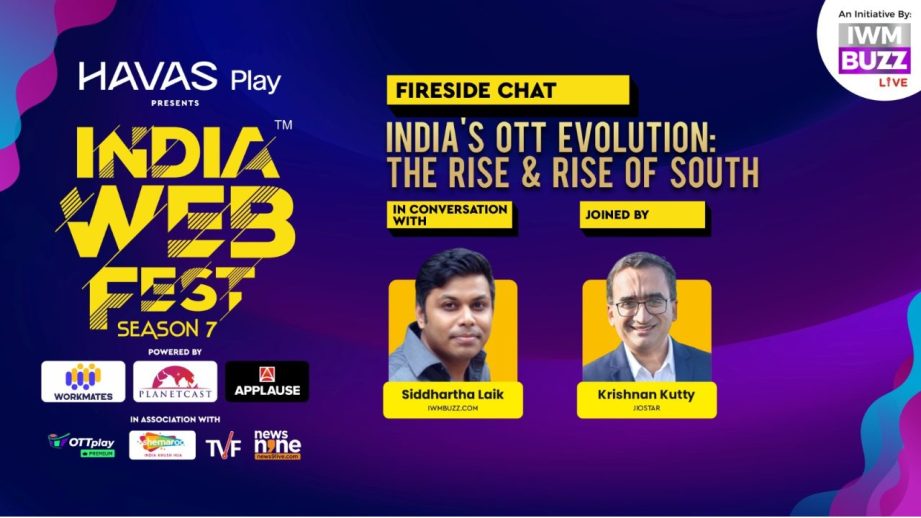
Marked 20th August. It was raining in Mumbai—not the kind of moment where you would expect people to show up in legions at an industry event. But as you flow into the India Web Fest 2025, the grey outside fades, and you see creatives in swarms—tech leads, media professionals, advertisers and others all in the quest to seek what lies next for the web.
It’s a global shift that we have been witnessing. And in India, this evolution propelled a transformation in content consumption. Indian audiences are gravitating towards regional portrayals, with the South arising as a cultural powerhouse. From Tamil thrillers to Telugu dramas, the appetite for authentic, rooted storytelling has grown—reshaping not just viewership patterns, but also content strategies across platforms.
Weaving the narrative, we got our ears on the fireside chat at the India Web Fest 2025—The Rise & Rise Of South. The conversation led by Siddhartha Laik, Founder & Editor-in-Chief, IWMBuzz Media and Krishnan Kutty, JioStar took a deep dive into the shifts and dynamics that propelled the change in the content consumption.
If rightly to put out in a liner, the chat coursed over 20 minutes contemplated on the evolving dynamics of south— a region that’s no longer just a “market” but a multi-lingual, multi-format, and multi-billion-dollar force reshaping how India watches content.
South India—Not A Monolith
One region with four distinct markets, Krishnan Kutty sets the tone right in the beginning of the conversation. The Southern Indian OTT landscape is composed of four distinctly vibrant markets: Tamil, Telugu, Malayalam, and Kannada. Each with its own audience behaviour, content appetite, and creative DNA. Krishnan Kutty mentioning Malayalam content standing out said that the script is unique and has no match.
Telugu entertainment, on the other hand, thrives on scale — big ideas, grand visuals, and mass appeal. Tamil strikes a balance between narrative richness and high-volume entertainment, while both Tamil and Telugu markets have shown a strong affinity for non-scripted formats. This regional segmentation demands a more granular, hyper-local approach — not just in content creation, but also in distribution, partnerships, and marketing.
Quality vs Quantity—A False Dichotomy
The catch got real there. In the world where we constantly say this in repeat ‘quality over quantity,’ Krishnan cut through the usual noise. He said that the biggest challenge is to tell a story that hits the mark, every time, and yet deflates the very wallets of production. OTT platforms are about rhythm. Consistency. A steady stream of content that keeps the audience hooked and subscriptions maintained. That’s the tightrope everybody’s walking now.
Consistency In Delivery Gets A Toast
In the old days, viewers built their week around shows. Wednesday at 9 PM meant one thing and one thing only. But OTT doesn’t come with that kind of built-in loyalty. Here, the rules are different, the stakes sharper. Krishnan put it plainly: if viewers don’t see something new waiting for them, they leave. See, that is how simple it is. From the view of the audience, the scroll is punishing. An auspicious silence feels like sharp betrayal from a platform. Behind those drops of binge-worthy content lies a shadowy war room. Content teams working with surgical precision mapping content calendars. Because in streaming, consistency, not just good to have-it is survival.
The Business Of Brands
For a long time, advertisers looked at Hindi content as the holy grail. Not anymore. Krishnan Kutty pointed out, “Southern markets are incredibly prosperous markets. you know they are among the top seven or eight most prosperous markets across the country.” He shared how shows like Heartbeat on Hotstar became brand magnets. Regional is now a strategy. Krishnan picked up the shift: branded content is getting smarter. Think exclusive podcasts built around fan-favourite characters, or immersive on-ground affairs tied to a show’s finale. It’s no longer about just being seen. It’s about being remembered, in the language people live their lives in.
Anchors And The Soul Of Bigg Boss
Any conversation about Southern OTT is incomplete without Bigg Boss, a franchise that has exploded in regional iterations. So, how does one choose the face of such a massive IP? Krishnan Kutty rightly points it out—calling anchors as the soul of the reality shows. Not just the star power that brings integrity, but it also lures it’s about credibility, relatability, and the integrity to hold a mirror to the audience. The right anchor doesn’t just carry the show; they are the show.
Genres & Experiments — What Works In The South?
Scroll through a South Indian OTT homepage today and you won’t just find the expected family sagas or high-stakes thrillers. There’s experimentation in the mix. Scripted dramas sit alongside reality formats, stand-up specials, and offbeat comedies. “Save the Tigers,” a Telugu comedy, comes up more than once in conversations — partly because it landed, and partly because it proved something.
Building The Future, One Story At A Time
As the fireside chat drew to an end, Krishnan’s words hung in the air, perforating the clamorous ambience of chaos in the industry with a rare moment of lucidity. No sweeping forecasts—just a focused view of what really matters: The young, restless viewer doesn’t wait around; making content that connects deeply and consistently; and the harsh truth of sustaining a business in the crowded OTT environment. JioStar’s wager on originals and sports is its chosen path; however, bigger than these is the picture before all: success is in the balance of scale and story; in whims and discipline. While AI, for now, is not a disruptor but a tool to be mastered, in the midst of all that noise, Krishnan’s closing thought was, “Tell great stories, often and well.” It was just one conversation, but one that set the tone for what’s next.
